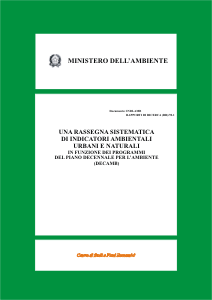CONTENTS
Preface
INTRODUCTION
FIRST PART: GENERAL ASPECTS
Chapter 1
The state-of-the-art: a general glance at international activities for the environmental indicators research
1. United Nations Economic Commission for Europe (UN-ECE)
2. World Health Organisation (WHO)
3. Organisation for Economic Co-operation and Development (OECD)
4. European Union (EU)
Chapter 2
The concept of welfare, indicators and programme indicators
1. Introduction
2. Programme indicators
3. Welfare measurement
4. Welfare measurement related to the physical environment
5. The particular case of the urban environment
Chapter 3
Indicators for the integration of environmental interests in sector policies
1. Nature of the sectorial indicators
2. Application of the sectorial indicators
3. Methodologies and criteria for the elaboration of the indicators
4. Examples of indicators
5. Orientations for the future
SECOND PART: SECTORIAL ASPECTS
Chapter 4
Indicators for the management of the urban environment
1. Definitions
2. Systems of indicators on metropolitan phenomena
3. The structure of the “urban environment” programme
4. Accomplishment of the “urban effect” standards in the field of the equipment with urban services
5. Accomplishment of the “urban effect” standard in the field of interpersonal, social and political relations
6. Indicators for the territorial management within the policy of the amelioration of the urban environment
Appendix to chapter 4: Indicators of the quality of life per spatial unit (OECD and United Nations)
Chapter 5
Environmental indicators for the conservation of nature
1. The achievement of a system of natural protected areas
2. The conservation of the natural protected heritage
Chapter 6
Environmental indicators of the atmosphere
1. The protection of the ozone layer
2. Stabilisation of the global emissions of CO2 by the year 2000 onto the levels of 1990
3. Reduction of at least 30% of the emissions of the principal atmospheric pollutants by the year 2000, responsible for the acid rain (SO2, Nox, organic volatile compost)
4. Reduction of the smog levels in “indoor” environments to acceptable levels
5. Reduction and/or conservation of the noise pollution level of the atmosphere specifically in centres of residence
6. Protection and improvement of environmental conditions regarding magnetisms and other phenomena of telluric and atmospheric radiation
Chapter 7
Environmental indicators for the water management
1. Ensure the improvement of the “Ecological Quality” (EQ) of inland water up to the point of reaching the level of an “Elevated Ecological Quality” (EEQ)
2. Ensure the safety of the water supply (in particular, drinking water) at all territorial levels in a balanced relationship between availability and consumption
Chapter 8
Environmental indicators for the soil management
1. Soil protection from deterioration connected with agricultural activities
2. Soil protection from deterioration connected with extractive activities
3. Soil protection from deterioration connected with anthropic activities (residential, productive and infrastructural)
4. Soil protection from negative effects produced by some natural events
Chapter 9
Environmental indicators for the waste management
1. The reduction of the quantity of waste produced
2. The reduction of the dangerousness of waste produced
3. The increase of the quantity of materials and energy exceeded by waste
4. The decrease of the environmental impact deriving from waste handling and disposal
5. The improvement of the overall waste management
Chapter 10
Environmental indicators for the forest management
1. The conservation and good usage of the forestal heritage
2. Extension of the forestal surfaces
Chapter 11
Indicators of environmental compatibility for agriculture
1. The reduction of the employment of agro-chemical products
2. The rationalisation of the disposal of zootechnical reflux
3. The increase of the genetic diversity
4. The improvement of the energetic efficiency in agriculture
5. The development of biological agriculture
6. The enlargement of agro-forestal space for protective and productive uses
Chapter 12
Indicators of environmental compatibility for transport
1. Reduction of air pollution caused by traffic
2. Reduction of the noise pollution caused by traffic
3. The pursuit of territorial structures with less transport intensity
4. The minimisation of the environmental impact of the infrastructure
5. The objective of saving human lives
6. The improvement of knowledge in order to improve transport planning
Appendix to chapter 12: Provisional system of environmental transport indicators elaborated by the OECD
Chapter 13
Environmental indicators for coast preservation
1. Recovery of brackish water
2. Organization of coast territories
3. The control and management of erosion phenomena
4. The protection of nautical ecosystems
Chapter 14
Indicators of the environmental compatibility of energy
1. Reduction of the growth of energy consumptions
2. Reduction of the emissions of CO2 in energy conversions
Chapter 15
Environmental indicators of industrial risks
1. Evaluation of the compatibility of the chemical industry
2. Improvement of the environmental compatibility of the existent (chemical) industry
3. Verification of the environmental compatibility of the new processes or products
4. Formation, information and research for a clean chemistry
5. Management of industrial risks
APPENDICES
I. ENVIRONMENTAL ACCOUNTING
1. Re-adaptation of national accounts
2. Environmental satellite accounts
3. Accounts of natural and environmental resources
4. Pilot accounts of the OECD
5. Perspectives
II. CLASSIFICATION OF SURVEY AREAS REGARDING THE CONSTRUCTION OF ENVIRONMENTAL INDICATORS (AS PROPOSED AT THE HEADQUARTERS OF THE UN-ECE, CEE AND OECD AND IN THE THOSE OF THE DUTCH AND CANADIAN GOVERNMENTS)
1. UN-ECE (United Nations Economic Commission for Europe)
2. CEE (Council for Environmental Education)
3. OECD (Organisation for Economic Co-operation and Development)
4. WHO (World Health Organisation)
5. The Netherlands
6. Canada
III. INDICATION OF BIBLIOGRAPHIC SOURCES FROM WHICH THE QUOTED INDICATORS HAVE BEEN DRAWN (AND ACCOUNTED FOR IN THE TEXT WITH A SYNTHETIC EXPRESSION OF THE SOURCE IN BRACKETS)
BIBLIOGRAPHIC REFERENCES
